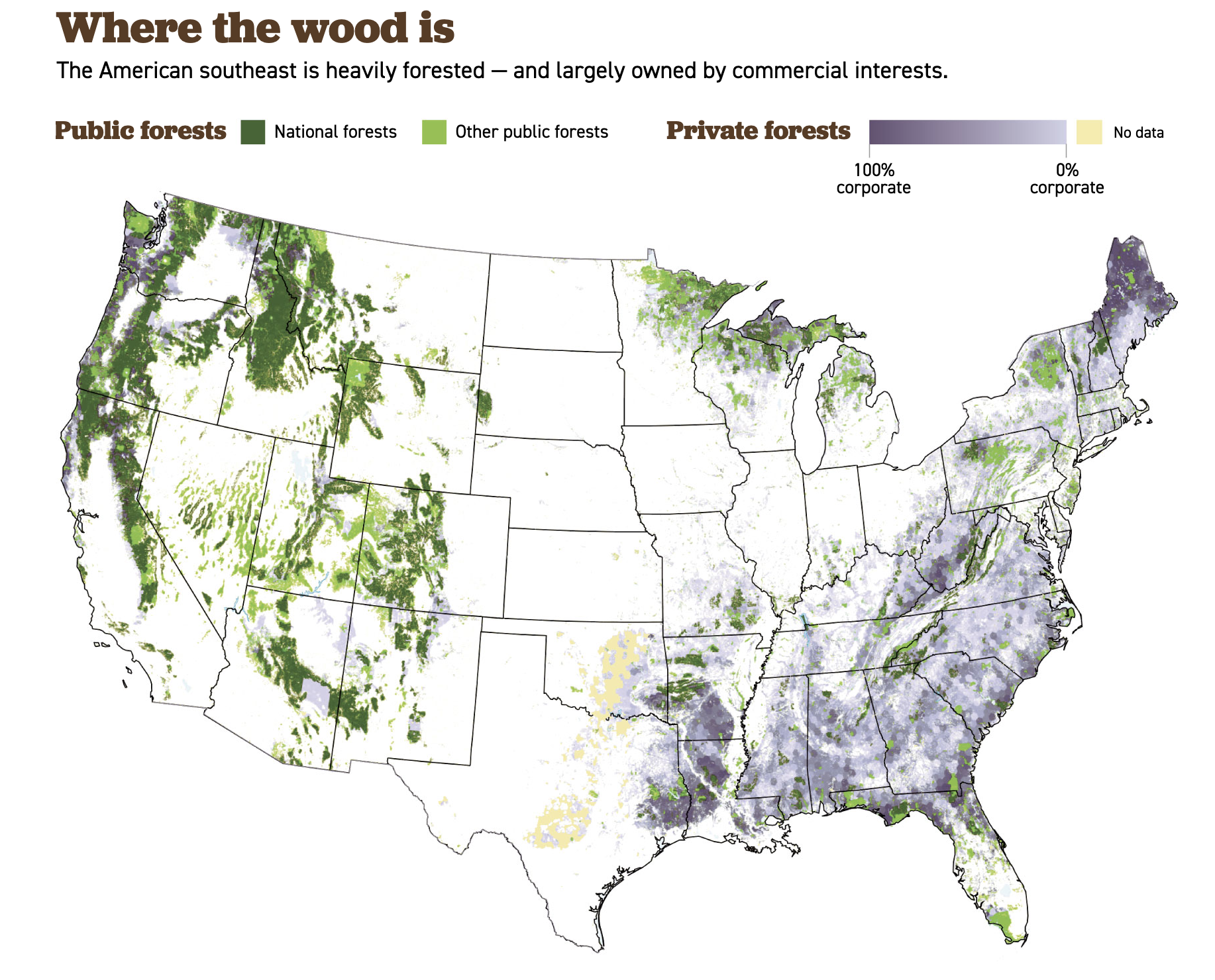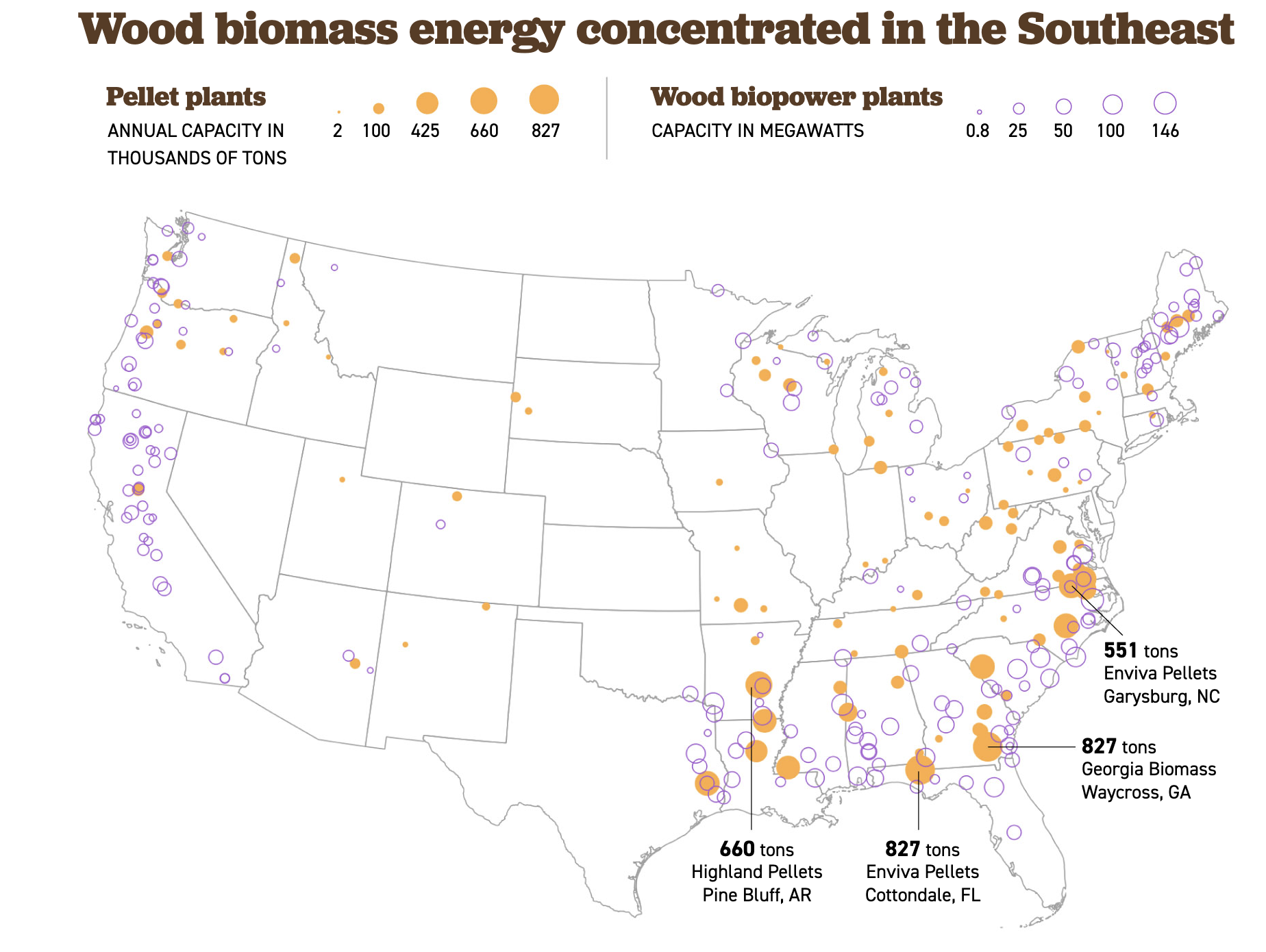When most Americans think about “green power” and Europe, they conjure up pictures of wind turbines and solar panels producing emission-free power. The truth, however, is that Europe makes more energy from wood than it does wind and solar. Policymakers around the world, including the United States, have declared that burning wood to generate electricity is not a climate threat, but a “green” power solution. In Europe, “biomass power,” is counted and subsidized as zero-emissions renewable energy. As a result, European utilities import millions of metric tons of wood from U.S. forests every year, and Europe’s utilities generate more energy from burning wood than from wind and solar combined. Biomass power is a $50 billion global industry, and growing.
The idea that generating electricity from wood could be carbon-neutral is bewildering because biomass emits more carbon dioxide than coal at the smokestack, plus there is additional carbon dioxide released by logging, processing logs into small pellets, and transporting them overseas. The argument, accepted by the world’s politicians, is that the carbon released while trees are burning should not count because it is eventually offset by the carbon absorbed while other trees are growing, making the power from it carbon neutral.
Deforestation is a major climate issue. Climate scientists would prefer the trees to grow and absorb carbon dioxide, indicating that converting wood into power is a forest destroyer and an inefficient way to generate energy. For example, solar panels can produce 100 times as much power per acre than biomass. And, supplying 2 percent more global energy from biomass would require doubling total global wood harvests.
Europe Is the Largest Consumer and Producer of Wood Pellets
The global wood pellet market is segmented into five major regional markets: North America, South America, Europe, Middle East and Africa, and Asia Pacific. Out of the five markets, Europe accounted for the major share in 2019. According to the U.S. Department of Agriculture, the European Union consumed an estimated 27.35 million metric tons of wood pellets in 2018, up from 24.15 million tons in the previous year—a 13 percent increase. Wood pellet consumption in the region was estimated to increase to 30 million metric tons in 2019, with imports increasing to 12.2 million metric tons from 10.355 million metric tons in 2018—an 18 percent increase.
The European Union had 656 pellet plants in 2017. In 2018, the United Kingdom was the largest consumer of wood pellets in the region (8 million metric tons), followed by Italy (3.75 million metric tons), Denmark (3.5 million metric tons), Germany (2.19 million metric tons), and Sweden (1.785 million metric tons). Europe’s efforts to achieve its emission targets committed to in the Paris climate agreement contributes significantly to its dominant usage of wood pellets. Supportive government initiatives and incentives also drive the growth in wood pellet consumption. For example, the Drax facility in England, which was the U.K.’s largest coal plant before it switched most of its operations to wood pellets, receives over $1 billion worth of annual subsidies.
United States Supplies Wood Pellets
The southeastern United States produces one-sixth of the world’s timber from its highly productive forests; about 4 percent are turned into pellets. The U.S. wood-pellet industry has built 23 mills throughout the southeast over the past decade, and is branding itself as a 21st-century “green” energy business. A facility in Northampton County, North Carolina, ships wood to the world’s largest biomass plant, in England. The United States exports over 4 times as many pellets as it consumes and its exports of wood pellets are growing. Wood pellets are consumed in highly efficient heating stoves in the United States, as well as in barbeque smokers and in the industrial and electric generating sectors.
The world’s leading pellet manufacturer, Enviva, built its first pellet mill in 2011, after Europe’s renewable energy mandate created lucrative incentives to burn wood. Enviva operates nine large mills around the Southeast that can debark and crush and process logs into more than 5 million tons of pellets a year, and there are three more mills in development. It also operates five ports to ship its pellets abroad, and has 1,100 employees, not including the loggers and truckers who supply its wood.
Enviva tries to be an environmental steward, requiring the landowners who supply its wood to replant their forests, and using GPS technology to track each harvest to see if the landowners are in compliance. Reforestation in the Southeast is very common and is considered an agricultural activity. The company has also committed to help protect 35,000 acres of threatened bottomland hardwood forests and restore 5,000 acres of natural longleaf pine. U.S. tree cover increased about 2 percent from 2007 to 2017.

Conclusion
The wood pellet industry is growing because politicians see wood consumption as carbon neutral with new trees absorbing the carbon dioxide released by combusting wood. Europe is the largest consumer of wood pellets due to its incentives and desire to reach its Paris climate commitments. Europe produces more energy from wood than from wind and solar. The U.S. wood pellet industry is growing and is a major supplier of wood pellets to European countries.




